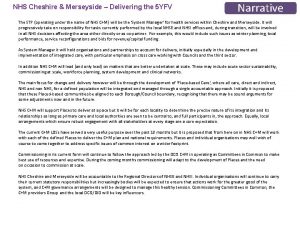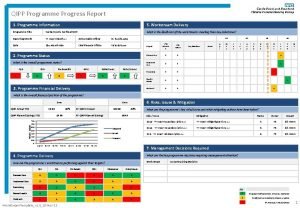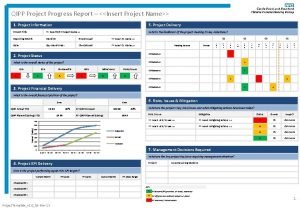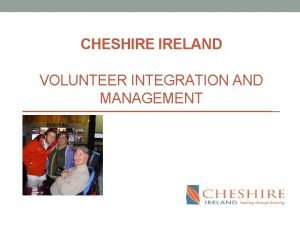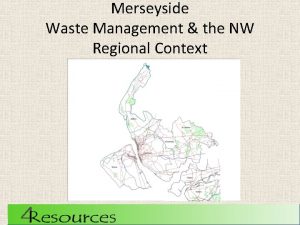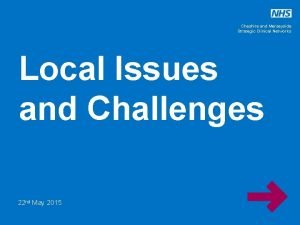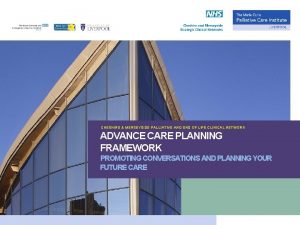Merseyside Cheshire Pathology QIPP Network Progress and Challenges










- Slides: 10

Merseyside & Cheshire Pathology QIPP Network “Progress and Challenges” Ken Barr Network Director

MCPN Pathology Network l 9 Trusts on 14 sites l 3 x Acute FT, 4 x Specialist FT, 2 x Acute l Population served ~1. 7 m l 5. 7 m requests per annum with 25. 8 m tests l 1, 030 staff l £ 64 m direct budget spend 2009/10 l ~12, 400 sq m lab space currently in use l QIPP savings target = £ 14 m

Pathology Network: Full Merseyside and Cheshire Population Served ~ 2. 4 m

Network Progress Vision: “To provide an efficient and effective Pathology service that is patient focused and clinically led, delivering measurable quality and performance that is continually improving” l Establish a singly managed Pathology organisation l Consolidate and re-design services using a hub & spoke model, supporting community and primary services to keep patients as close to home as possible l Through clinical leadership reduce inappropriate variation in tests and results via standardisation of operating processes and protocols, using evidence-based best practice l Invest in IT connectivity to improve access to information to support patients/NHS staff with the right services at the right time in the right place l Establish a single Pathology Integrated Board to manage and deliver pathology services in the most efficient and effective manner to save £ 14 m by 2014/15

Outline Business Case l Single managed network with single identity/employer l l ‘Carter consolidated model’ – hub and spoke concept l l Cost benefit analysis to include access to peer support, R&D, training, MDTs etc. Clinically led integrated services l l Improve standardisation, quality, efficiency based on agreed TAT Centralise specialist and sub-specialist services l l NHS host, social enterprise, JV Centralise multi-discipline, automated, non-urgent testing l l Flexibility to reuse/rent space as available and affordable Explore options for single business structure l l Remove historic organisational barriers and deliver services to population/GPs Respond to population/patient needs - improve access & patient experience Increased efficiency l Reduce direct spend from £ 64 m to £ 50 m over four years (>20%)

Challenges: Pathology Information Systems l 7 different types of LIMS in MCPN - some integrated to PAS systems l Cost issues – need migration plan funded via overall efficiencies l Keep track of referred test and samples within and outside the network l Procure same analytical equipment – avoid risk of poor standardisation l Many interfaces required, order comms/reporting, GP messaging, cytology recall, GUM, cancer registry, infection control etc. l Operational – report printing, management, finance, audit, R&D l Many supporting IT systems – document management, supplies, asset register, risk register, QC information l POCT connectivity, order and result comms to community/primary sectors

Transport • Key to making the network viable – Pathology specific • May require temperature regulated vehicles on longer routes • May utilise motorcycles couriers on shorter routes • Needs to be flexible, based on “zones” + ad-hoc collections • IT tracking, specimen numbers, collection times, management • Specialist companies are already in use – need scaling up ensure VFM via formal specification and tender

Biochemistry – Spoke Tests Alanine transaminase (ALT) Albumin Alkaline phosphatase Ammonia Amylase Aspartate transaminase Bilirubin (total and conjugated) Blood gases and lactate (use ward -based instruments) Bicarbonate Calcium [Cortisol] Carboxyhaemoglobin (ward) Chloride C-reactive protein Creatine kinase Creatinine Digoxin Ethanol (alcohol) Glucose Human chorionic gonadotrophin [Iron] Lithium Magnesium Osmolality Paracetamol Phosphate Salicylate [TFTs] Total protein [Transferrin] Troponin Urate Urea CSF Glucose Total protein Xanthochromia screen Urine Creatinine Osmolality Potassium PBG Sodium Copyright of Kent & Medway Pathology Network

Haematology ~ 3 m tests HUB (60%) Urgent FBC and coagulation Routine FBC and coagulation Full Blood Transfusion service ESR GFST Sickle screens Malaria investigations B 12 & Folate Hb Profile G 6 PD Immunophenotyping Bone Marrow Asp CSF Cytospin Cytochemistry Thrombophilia LUPUS Factor assays (exc FVIII) Plasma Heparin (Xa) HIT screen Platelet Aggregrations MTHFR, Leiden, PTGM SPOKE (40%) Urgent FBC and ESR Urgent coagulation Full Blood Transfusion service Sickle screens Malaria investigations Copyright Kent & Medway Pathology Network

Next Steps l Develop OBC/Service Spec with external management support l l CEO decision on business model/delivery method l l Commence consolidation during 2011/12 Meaningful consultation/communication with staff and stakeholders l l by April 2011 Estate ‘hub’ option appraisal l l by March 2011 To commence November now CEOs have approved OBC work Project team to develop and deliver implementation plan 2011 -2015 l April 2011
 Cheshire and merseyside training hub
Cheshire and merseyside training hub Cheshire and merseyside stp
Cheshire and merseyside stp Qipp programme
Qipp programme How to report project progress
How to report project progress Asylum link merseyside
Asylum link merseyside Physical progress and financial progress
Physical progress and financial progress Trickster archtype
Trickster archtype The devil can cite scripture for his purpose fahrenheit 451
The devil can cite scripture for his purpose fahrenheit 451 Cheshire ireland pay scale
Cheshire ireland pay scale Fahrenheit 451 pages 89-106 summary
Fahrenheit 451 pages 89-106 summary Cheshire constabulary
Cheshire constabulary

